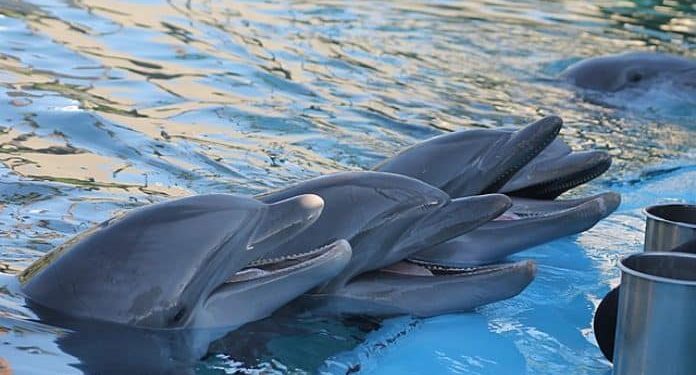An international team of scientists led by experts at the University of Bristol has revealed that male bottlenose dolphins establish the largest known multi-level alliance network outside of humans.
These cooperative interactions between groups facilitate male access to a scarce resource.
In order to reconstruct the structure of alliances between 121 adult male Indo-Pacific bottlenose dolphins at Shark Bay in Western Australia, the researchers, along with collaborators from the Universities of Zurich and Massachusetts, examined association and consortship data.
The Proceedings of the National Academy of Sciences published their findings (PNAS).
Shark Bay male dolphins group together in first-order alliances of two to three males to cooperatively seek out specific females for relationships.
For access to female dolphins, second-order coalitions of four to fourteen unrelated males fight with one another while third-order alliances form amongst collaborating second-order alliances.
Dr. Stephanie King, an associate professor at Bristol’s School of Biological Sciences and the co-lead author, explained, “Cooperation between allies is widespread in human societies and one of the hallmarks of our success. Our capacity to build strategic, cooperative relationships at multiple social levels, such as trade or military alliances both nationally and internationally, was once thought unique to our species.
“Not only have we shown that male bottlenose dolphins form the largest known multilevel alliance network outside humans, but that cooperative relationships between groups, rather than simply alliance size, allows males to spend more time with females, thereby increasing their reproductive success,” Dr. King added.
According to Dr. Simon Allen, a study participant and Senior Lecturer at Bristol’s School of Biological Sciences, “We show that the duration over which these teams of male dolphins consort females is dependent upon being well-connected with third-order allies, that is, social ties between alliances leads to long-term benefits for these males.”
Characteristics That Set Humans Apart From Chimpanzees
The emergence of pair bonds and male parental care were considered to be two further characteristics that set humans apart from our common ancestor with chimpanzees. These were necessary for intergroup cooperation in humans.
Richard Connor, Professor Emeritus at the University of Massachusetts who is now associated with Florida International University, co-led the study with Dr. King and noted that the findings “show that intergroup alliances can emerge without these features, from a social and mating system that is more chimpanzee-like.”
The team celebrated the 40th anniversary of the beginning of Shark Bay dolphin research in 1982 along with the 30th anniversary of the publication of their discovery of two levels of male alliance formation in 1992, also published in the Proceedings of the National Academy of Sciences. The importance of third level or intergroup alliances in dolphins will be published in 2022.
Professor Dr. Michael Krützen, the author of the study and director of the Anthropology Institute at the University of Zurich, added that “it is rare for non-primate research to be conducted from an anthropology department, but our study shows that important insights about the evolution of characteristics previously thought to be uniquely human can be gained by examining other highly social, large-brained [species].”
Furthermore, Dr. King said, “Our work highlights that dolphin societies, as well as those of nonhuman primates, are valuable model systems for understanding human social and cognitive evolution.”
In conclusion, studies have demonstrated that male bottlenose dolphins develop intricate social relationships with one another. Even though dolphins are not the only species to do so, scientists are discovering more and more proof that they have many traits in common with humans.




















